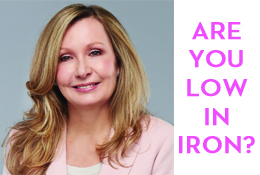An interview with Lorna Vanderhaeghe
by Jason Sebeslav, Owner of The Peanut Mill Natural Foods Market
Lorna Vanderhaeghe, MS, is a leading women’s health expert and has been researching nutritional medicine for over 25 years. With degrees in nutrition and biochemistry, she is a popular lecturer and the author of 10 books including A Smart Woman’s Guide to Hormones and A Smart Woman’s Guide to Weight Loss. I recently had the opportunity to ask Lorna about a “hidden” but serious health issue: iron deficiency.
Jason Sebeslav: Lorna, you’ve researched and lectured extensively on the problem of low iron status and its negative effects on health. How common is this problem and why should we be concerned?
Lorna Vanderhaeghe: One in four women has low iron or iron deficiency anemia. And you do not have to be “officially” diagnosed as anemic to feel or see the effects of low iron, such as fatigue, hair loss, peeling fingernails, poor concentration, heart palpitations, pale skin and dark under-eye circles. Iron is also needed for manufacturing estrogen, progesterone and serotonin—your “happy” hormone. For all these reasons, low iron is a serious concern.
JS: So it’s more of a problem for women?
LV: Well, women are more susceptible than men due to blood loss during monthly cycles. But research shows that many men, children and elderly people are also deficient in iron because we are just not getting enough iron from our diet. We all require up to 20 milligrams of iron daily, but most of us get less than eight milligrams per day from food.
JS: With regard to blood test results, what numbers would you say we should be looking for to gauge whether or not we have adequate iron?
LV: Most doctors will tell you your iron is fine as long as you don’t have anemia, so many people aren’t aware they are on the low side. But low levels can cause many of the health concerns I mentioned. Always ask for a copy of your test results. There are two tests: Hemoglobin and Ferritin. Ferritin is your iron storage and is the more important test. For hemoglobin, the range is 117-160g/L for women and 131–180 g/L for men. We should be around 140 g/L. For ferritin, the range is 15–160 ug/mL for women and 15–410 ug/mL for men. However, women will begin to lose their hair if ferritin is below 70 ug/mL.
JS: In your research on the various forms of iron, what did you find out that led you to settle on the liposomal form featured in your IronSmart supplement?
LV: Standard iron supplements prescribed by the doctor include ferrous fumarate and ferrous sulphate. They cause terrible stomach upset and constipation. Most people can’t take them for more than a couple of weeks, yet it takes a full year on these iron supplements to raise ferritin. I met researchers in Europe who had a special liposomal iron that did not constipate and raised hemoglobin and ferritin quickly—it actually doubled levels in only 12 hours. And it tasted great—like Werther’s candies! Liposomal iron is so safe that everyone including children, and pregnant and breastfeeding women should use it.
JS: You have four children and five grandchildren. At what age do you suggest giving children an iron supplement?
LV: All of my children and grandchildren got a multivitamin with minerals including iron from the time they were born. All of my children were breastfed, and by six months we should be giving our babies iron. IronSmart has the children’s dosage on the label.
JS: We’ve heard reports that supplemental iron may be detrimental to seniors, particularly men. What are your thoughts on this, and is this a concern for senior women as well?
LV: Some people may have a genetic condition where their iron levels get dangerously high. Thankfully this is rare and those affected can give blood to keep iron in check. The idea that senior women don’t need iron because they are no longer menstruating is ridiculous. So many senior women are losing hair, have poor memory and low energy because their doctor simply won’t test their iron! I think all senior women need 10 mg of IronSmart to ensure they are getting this very important mineral.
View or download a free 16-page booklet on iron, including an iron-deficiency checklist.
This interview was published in HWS Magazine in Oct 2017

